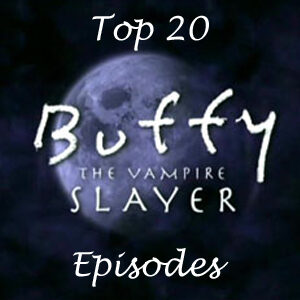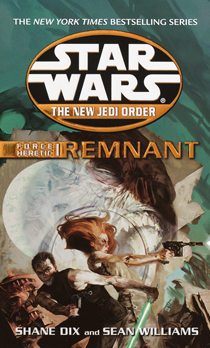Featuring a lot of dangling plot threads from the “New Jedi Order” and the entire Expanded Universe, “Force Heretic I: Remnant” (2003) – the 15th book in the “NJO” and first of a trilogy – is the best-plotted novel of the saga so far. It’s the debut “Star Wars” effort from Sean Williams – who would go on to be known for his action-heavy video-game tie-ins under “The Old Republic” and “The Force Unleashed” banners – and Shane Dix, whom I’m tempted to credit with the more subtle and deeper aspects of this book. This trilogy marks Dix’s only “Star Wars” contributions other than a Star Wars Insider short story called “Or Die Trying,” also written with Williams.
The EU is filled with almost as many compelling paths-not-taken as paths-that-ARE-taken. What’s so cool about “Remnant” is that it reinvigorates many ideas that had been shelved while chronicling two Galactic Alliance missions. Jacen, Luke, Mara, Danni, Saba and Tekli travel to the Empire to make another plea for a military alliance; Jaina, Han, Leia, Jag and Tahiri travel to Galantos, where communications have been cut off. The way the authors pick out teams of characters for these missions reminds me of “X-Men” comic books, but it’s a good call to focus on distinct groups after the sprawling galaxy-shaping events of the previous book, “Destiny’s Way.” In the way they take the time to explore details – such as the culture of Galantos – Williams and Dix’s writing reminds me a bit of the exploratory style of Brian Daley’s “Han Solo Adventures.”
Of the two missions, I enjoyed the Galantos journey more, whereas the Empire mission has wider galactic implications.
Galantos is a neighbor of the Koornacht Cluster, home of the Yevetha. The villains of the imperfect but fairly smart “Black Fleet Crisis” trilogy, the Yevetha were the Yuuzhan Vong on a smaller scale: warmongering aliens who conquer for the sake of conquering, with a strict hierarchy among their populace. The authors set an ominous tone as our heroes realize that the meek Fia, the natives of Galantos, are no longer scared of their galactic neighbors. You can probably guess what Jaina finds – or doesn’t find – when she investigates N’zoth: the Yevetha have been wiped out by the Vong.
And before the Yevetha, we met the Ssi-ruuk, another proto-Vong species. A creepy alien race that threatened neighboring Bakura with technology whereby it imprisoned captives’ life forces, the Ssi-ruuk were introduced in “The Truce at Bakura.” The “Force Heretic” trilogy promises that Leia’s team will visit Bakura next as it continues to check in on planets whose communications have been cut off from the Galactic Alliance. (This is the book where the former New Republic begins to be called the Galactic Alliance, which is short for the Galactic Federation of Free Alliances, which not coincidentally shares an acronym with “Galaxy Far, Far Away.” This semi-new government somewhat unconvincingly held an election amid the disruptive war in “Destiny’s Way,” and the citizenry elected Cal Omas as the chief of state.)

Other nice mysteries come from Tahiri’s split personality – she had some serious Vong implants back in “Edge of Victory I: Conquest” – and an unidentified helper on Galantos, who turns out to be a Ryn. We best know the Ryn from Droma’s stint as Han’s co-pilot, most recently in the “Agents of Chaos” duology.
The other Galactic Alliance team, meanwhile, heads toward the Unknown Regions to pursue rumors of the living, hyperspace-capable planet Zonama Sekot, which Luke and Jacen – as per information from the late Vergere – believe might prove crucial in the war against the Vong. Zonama Sekot was introduced in “Rogue Planet,” which was a combination of a post-“Episode I” Anakin/Obi-Wan novel and a teaser of “NJO” elements. The Chiss territory is also on the mission’s itinerary.
But before Jacen’s team gets to Chiss space or Zonama Sekot, they stop in the Imperial Remnant and we get the most epic Empire/Galactic Alliance team-up so far, culminating in Grand Admiral Pellaeon finally agreeing that the Empire should formally join the Alliance (while maintaining its sovereignty within it). While the battle writings aren’t bad, these authors’ strengths are dialogue-heavy scenes. A highlight is when Pellaeon announces the alliance to his assembled Moffs and we get heated arguments on both sides.
Scenes featuring Pellaeon are always oddly compelling. The Empire is, of course, an oppressive authoritarian state, but the grand admiral is often portrayed as a relatively decent man within that structure. Less arrogant than Imperials of the classic trilogy era, Pellaeon even notes on page 395 that the New Republic/Galactic Alliance has ruled the bulk of the galaxy for nearly as long as the Empire, “and with less bloodshed and military expenditure, I might add.”
On the same page, Williams and Dix address a discussion point that’s popular among fans: How would Palpatine’s Empire, at the height of its powers, fare against the Vong invasion? Pellaeon dismisses the argument from an anti-Alliance moff quickly: “We weren’t able to resist a handful of Rebels, so how would we have resisted the massed might of the Yuuzhan Vong?”
Interestingly, “Survivor’s Quest” directly tied the Yuuzhan Vong into Imperial history by suggesting that Grand Admiral Thrawn’s attack on the New Republic in the “Thrawn Trilogy” was a deliberate warmup act for facing the Vong, whom the Chiss vaguely knew about from back in the time of “Rogue Planet.” (Perhaps we’ll learn more about the Chiss’ knowledge of the Vong in the next book, “Refugee.”) As one military man in the Unknown Regions says: “The only reason Thrawn came back to attack the New Republic in the first place was to whip us into fighting shape for some danger looming out there at the edge of the galaxy.” Before it was canceled and Disney opted to reboot the “Star Wars” storyline, “The Clone Wars” TV series also planned to include the Vong in a story, at least peripherally.
Playing as an extra undertone in “Remnant” is that Jacen leads the battle against the Vong from the bridge of an Imperial Star Destroyer, presaging – probably on purpose – his surprising authoritarian turn in the “Legacy of the Force” series.
I had thought the hints of a Jacen-Danni romance way back in the first two books of the “NJO” were a path not taken, but it gets rekindled (although Jacen is oblivious) in “Destiny’s Way,” and the pairing becomes giggle-worthy in “Remnant.” After Luke accidentally walks in on an intimate moment between Jacen and Danni (page 408), Jacen sees it as a reprieve, noting that he’s no good at that sort of thing anyway. Luke shares a rare bit of non-Force-based wisdom with his nephew:
“Getting a relationship to work is almost impossible. There’s no right or wrong way to tread; the rules are made up as you go along and can change without warning. Trust me when I say that it makes being a Jedi look easy.”
In its third plotline, “Remnant” follows disgraced Yuuzhan Vong Executor Nom Anor as he ventures through the underworld of Yuuzhan’tar (formerly Coruscant) and falls in with a community of Shamed Ones. Stoking hope for a better future for themselves, the Shamed Ones are sharing the story of a heroic Jedi and a redeemed Vong teaming up on Yavin IV. This is a great way to show how oppressive cultures are ultimately overthrown – at least in part — from within, and I love the way Williams and Dix make Anakin’s hero’s journey in “Edge of Victory” into a central story point; the character is dead, but his legacy lives on.
Overall, I enjoy the way “Remnant” takes its time and allows a reader to savor adventures in various corners of the galaxy. Rather than ending with a boffo space battle, it spends a good chunk of the final pages in a reflective mode. Jacen’s group and Jaina’s bunch talk in a holo-transmission about their next destinations, and it feels a lot like the end of “The Empire Strikes Back.” We’ve enjoyed a great chapter, and we’re left with the promise of another one ahead.

